
Imbolc, also spelled Imbolg, is one of the four Greater Sabbats. Also known as Brigid’s Day or St. Brigid’s Day, it is one of the two Pagan sabbats clearly identified with a specific goddess or god – the other is Lughnasadh / Lammas. Imbolc is observed annually on February 2nd which is approximately halfway between the winter solstice (Yule) and the spring equinox (Ostara).
Although the spring equinox is officially the first day of spring in many countries including Canada, the ancient Celtic calendar historically established Imbolc as such. As such, contemporary Pagans celebrate the earliest stirrings of Earth’s return to life during this sabbat, the first of the three annual fertility festivals.
HISTORICAL IMBOLC
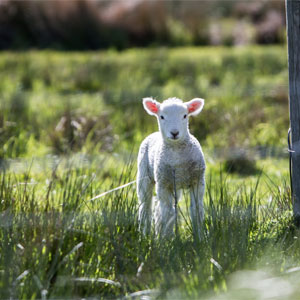 Not much is known about how ancient Celtic peoples feted this day but the word imbolc comes from an Irish word that means “in the belly.” It historically referred to the beginning of the lambing season in early spring, which would have been cause for celebration. While Imbolc itself is primarily a Celtic festival, many other ancient cultures also honoured this seasonal transition for various reasons including their survival of winter, especially in harsher Northern climates where mortality rates could be quite high.
Not much is known about how ancient Celtic peoples feted this day but the word imbolc comes from an Irish word that means “in the belly.” It historically referred to the beginning of the lambing season in early spring, which would have been cause for celebration. While Imbolc itself is primarily a Celtic festival, many other ancient cultures also honoured this seasonal transition for various reasons including their survival of winter, especially in harsher Northern climates where mortality rates could be quite high.
Although Brigid, the Celtic goddess also called Bride, Brigit, and Brighde, is widely recognized as the patron deity of Imbolc, little is known about how this connection developed. Perhaps it’s because in her manifestation of the maiden aspect of a goddess, she is associated with change, childbirth, fertility, fire, healing, renewal, and transformation. She is symbolized by candles, Brigid’s Cross, and corn dollies which are believed to protect the coming season’s crops.
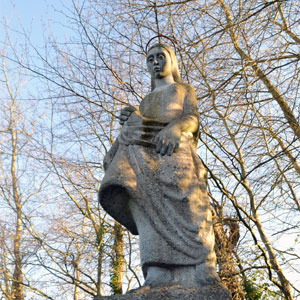 At some point, the goddess Brigid is believed to have become St. Brigid, integrated into the Catholic faith in the same way that Yule (Christmas) was. These integrations were intended to encourage Pagans to convert to Christianity. Consequently, St. Brigid was sometimes identified as being the Virgin Mary’s midwife during the birth of Jesus Christ, though there is no evidence of this. Historically, Brigid Day festivities began in the evening of February 1st and ended in the evening of February 2nd. As such, St. Brigid’s Day came to be observed by Christians on February 1st. However, many Pagans and Christopagans continue to commemorate her on February 2nd during Imbolc instead.
At some point, the goddess Brigid is believed to have become St. Brigid, integrated into the Catholic faith in the same way that Yule (Christmas) was. These integrations were intended to encourage Pagans to convert to Christianity. Consequently, St. Brigid was sometimes identified as being the Virgin Mary’s midwife during the birth of Jesus Christ, though there is no evidence of this. Historically, Brigid Day festivities began in the evening of February 1st and ended in the evening of February 2nd. As such, St. Brigid’s Day came to be observed by Christians on February 1st. However, many Pagans and Christopagans continue to commemorate her on February 2nd during Imbolc instead.
In addition, the Christian feast Candlemas also falls on February 2nd. This is the day that Mary and her husband Joseph were believed to have presented her newborn son, Jesus, at the Jewish temple. This would have taken place 40 days after the child’s birth for Mary to undergo her post-birth ritual cleanse and purification. Since Jesus is often called “The Light of the World,” he is represented by candles and on this day, Christians will bring candles to their churches to have them blessed in Jesus’s name. Since the date of Candlemas is probably the result of the Christianization of Imbolc, candles and purifications and even St. Mary have become a part of the present-day Pagan sabbat.
CONTEMPORARY IMBOLC
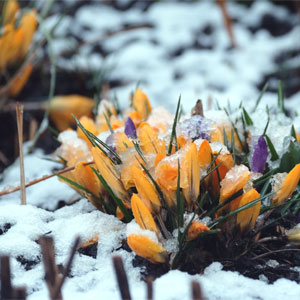 Modern Paganism has somewhat merged elements of all four of the ancient celebrations into contemporary Imbolc observances and festivities honoring: the very earliest stirring of spring; the end of winter being in sight; fertility and birth; change and transformation; cleansing and purification.
Modern Paganism has somewhat merged elements of all four of the ancient celebrations into contemporary Imbolc observances and festivities honoring: the very earliest stirring of spring; the end of winter being in sight; fertility and birth; change and transformation; cleansing and purification.
As such, Imbolc is a time of hope and renewal when contemporary Pagans look inward, making positive changes in their lives, such as cleansing and purification rituals; starting a positive new habit; and reconnecting with old friends. It is also a favourable time for conception and fertility spells.

IMBOLC MAGICKAL CORRESPONDENCES
MAGICKAL & SPIRITUAL INTENTIONS: Beginnings; change; childbirth; cleansing; clearing; dispelling; fertility; hope; new beginnings; patience; positive habit forming; pregnancy; purification; renewal; transition; transformation.
 ANIMALS: Bear; deer; groundhog; sheep; wolf.
ANIMALS: Bear; deer; groundhog; sheep; wolf.
COLOURS: Green (light); pink; white; yellow.
CRYSTALS & STONES: Amethyst; ametrine; bloodstone; moonstone; onyx; turquoise; violet flame opal.
DECORATIONS & SYMBOLS: Brigid, St. Brigid, and/or St. Mary statue or imagery; Brigid’s Cross; corn dollies; green & white candles; lamb & sheep statues; newly planted seeds in a small pot.
ELEMENT: Fire.
ESSENTIAL OILS: Basil; cedar; frankincense; holy basil; rose.
FLOWERS: Crocus; daffodil; snowdrop.
FOOD & DRINK: Ale; bread; blackberry tea; cakes; chamomile tea; cheese; cider; dairy products; dried fruit; eggs; grains; honey; mead; muffins; nuts; seeds; spiced wine.
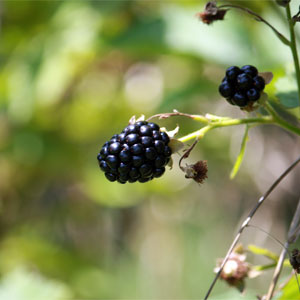 FRUIT & VEGETABLES: Blackberries; potatoes.
FRUIT & VEGETABLES: Blackberries; potatoes.
HERBS & SPICES: Basil; chamomile; holy basil.
INCENSE: Cedar; frankincense.
METALS: Brass; gold.
SMUDGES: Cedar leaves; frankincense resin.
TOOLS: Athame; besom for metaphysical clearing; cauldron or other eco-friendly fire-safe vessel for smudging; feather.
TREES & SHRUBS: Birch; blackberry; blackthorn; cedar; rowan; sycamore; willow.
IMBOLC CELEBRATIONS
Although Imbolc is one of the quieter sabbats, there are many ways to incorporate it into your life. You can make your observances as informal or as festive as pleases you. You can celebrate with family and friends or you may feel more introspective, choosing to observe it on your own. There’s no one right way to commemorate any sabbat so it’s best to embrace traditions that you’ll enjoy repeating year after year.
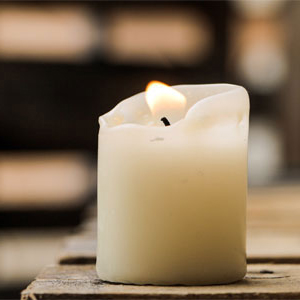 Decorate your altar or other sacred space as well as your home for Imbolc with items such as fresh green and white candles, lamb and sheep statues, a Brigid’s Cross, a new corn dolly, and/or a small pot with newly planted herb seeds – all of which symbolize this sabbat.
Decorate your altar or other sacred space as well as your home for Imbolc with items such as fresh green and white candles, lamb and sheep statues, a Brigid’s Cross, a new corn dolly, and/or a small pot with newly planted herb seeds – all of which symbolize this sabbat.
As a symbol of hope, light a single green or white candle to signify this early glimpse of spring as being the light at the end of winter’s long tunnel.
Replace used up candles with fresh ones. Keep any wax from used candles to melt together and craft a new candle or two using glass jars and natural wicks.
Ask Brigid to bless your candles for the upcoming year by placing them on your altar or sacred workspace. Write your own invocation or recite the following one:
Goddess Brigid, bless these candles,
so they’ll burn so true and bright.
Favour them with hope and wisdom,
so they’ll guide me with their light.
Goddess Brigid, bless these candles,
so they’ll burn so bold and strong.
And bless them with the Earth’s pure magick,
so they’ll help me all year long.
Take a cleansing purification bath to rid yourself of any negative energies and thoughts. Prepare what you’ll need ahead of time, for example herbs, essential oils and a clean white towel used only for magick baths.
Do a metaphysical spring cleaning of your home to rid it of negative energies by smudging and/or sweeping them out.
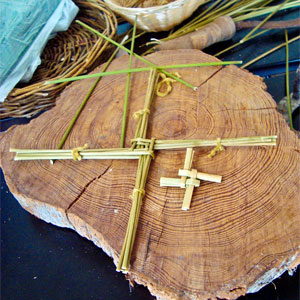 Craft a Brigid’s Cross and/or corn dollies for your altar.
Craft a Brigid’s Cross and/or corn dollies for your altar.
Cleanse, bless and dedicate any new magickal tools.
Purify and refresh your other permanent magickal tools such as athames, cauldrons, crystals, and wands. Gently remove any visible dirt from them, using a method appropriate to the tool. Then smudge them afterward with cedar leaves.
Start planning your garden, getting it ready for planting. Get seeds, pots and seed trays ready by organizing what you already have on hand and purchasing what you will need for to start your garden plants. Perform a seed-blessing spell, to ensure that your seeds will be at their most fertile. You could even plant seeds for plants that take a little longer to mature.
This is also a good time to work on your houseplants and indoor herbs. Take the opportunity to transplant houseplants to bigger pots, if needed; separate larger plants into two or more smaller plants or take cuttings and root them, all of which you can then share with family and friends.
If you have a complicated habit to form, such as eating healthier, prepare your plan of action and gather any items or products you may require.
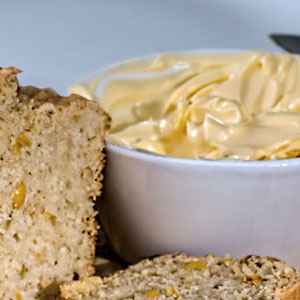 If you are planning a pregnancy during the upcoming year, Imbolc is a time to perform a fertility conception spell or ritual. Honey Butter is a simple, delicious yet effective fertility recipe spell.
If you are planning a pregnancy during the upcoming year, Imbolc is a time to perform a fertility conception spell or ritual. Honey Butter is a simple, delicious yet effective fertility recipe spell.
If you are already pregnant, this is also a time to perform a childbirth spell or ritual.
Do something positive for someone else as this will renew you. It doesn’t have to be anything big – simply paying a heartfelt compliment to someone or paying a small favour forward. This will not only make the other person feel good but it will recharge you as well.
Create your own personalized Imbolc ritual and/or celebration, something that has significance to you that also embodies the meaning, which you’ll enjoy repeating every year.
To find more detailed information on Imbolc and the other sabbats, please refer to our Bibliography.
If you are infertile for whatever reason, fertility and/or conception spells will not work. They can only increase the probability of conception, not correct infertility issues. Also, magick should never be used to take the place of advice from a physician, midwife, or any other healthcare professionals nor to delay the seeking or utilization of such health and medical advice.
IMPORTANT: COVID-19 has greatly changed our ability safely interact with others who do not live in our households. Imbolc celebrations, however, can still be meaningful nonetheless. Many of the suggested activities can easily be carried out alone or with household members. Otherwise, you can include other family and friends via phone call, video call, and group chats.
Photos & Images: images-free.net · CC0 1.0 / Free-Photos · Pixabay · license / Laineylee · Wikimedia Commons · CC BY-SA 4.0 · adapted / dreamstime · CC0 / Stefaan Van der Biest · Pixabay · license / jessemler · Pixabay · license / John-Mark Smith · Unsplash · license / CEllen · Wikimedia Commons · CC BY-SA 4.0 · adapted / Steve Buissinne · Pixabay · license
